Is Whitewashing A Big Deal?
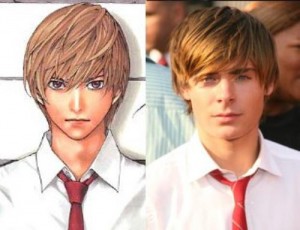 Next year, we’ll actually be getting not one, but two major Hollywood productions based on anime series – “Ghost in the Shell”, starring Scarlett Johansson, and “Death Note”, starring Nat Wolff. Both adaptations have been trying to get off the ground for a really long time now (“The Matrix” was originally supposed to be a “Ghost in the Shell” adaptation, but the Wachowskis didn’t think they’d get the rights, so they took some main themes and styles and presented them in their own way, while “Death Note” had a failed adaptation with Zac Efron, which was a real shame because Zac Efron is literally Kira), so I’m actually really excited to see how they turn out! You already know that most anime adaptations are terrible, so if those two also suck, at least they’ll provide us with an entertaining experience, and maybe a fresh perspective on some beloved characters. And, of course, there’s always the chance that they might surprise us and turn out to be pretty damn awesome, which is what I’m rooting for! In any case, that’s not what I’m here to talk about. Instead, there’s another, more interesting topic that these movies touched on – the topic of whitewashing.
Next year, we’ll actually be getting not one, but two major Hollywood productions based on anime series – “Ghost in the Shell”, starring Scarlett Johansson, and “Death Note”, starring Nat Wolff. Both adaptations have been trying to get off the ground for a really long time now (“The Matrix” was originally supposed to be a “Ghost in the Shell” adaptation, but the Wachowskis didn’t think they’d get the rights, so they took some main themes and styles and presented them in their own way, while “Death Note” had a failed adaptation with Zac Efron, which was a real shame because Zac Efron is literally Kira), so I’m actually really excited to see how they turn out! You already know that most anime adaptations are terrible, so if those two also suck, at least they’ll provide us with an entertaining experience, and maybe a fresh perspective on some beloved characters. And, of course, there’s always the chance that they might surprise us and turn out to be pretty damn awesome, which is what I’m rooting for! In any case, that’s not what I’m here to talk about. Instead, there’s another, more interesting topic that these movies touched on – the topic of whitewashing.
You see, “Death Note” is about a Japanese high school student who finds a notebook with the ability to kill people whose names are written within and decides to use it to ascend to godhood, and his struggle against the British detective of Japanese descent who is dispatched to catch him. “Ghost in the Shell”, while set in the future, stars Major Motoko Kusanagi – a cyborg heading a law enforcement division in a cyberpunk future. As you may have noticed, both of those characters are Japanese, and yet the actors who will be playing them in their live action adaptations, Nat Wolff and ScarJo, are very much not Japanese, or even Asian. That led to numerous news sources denouncing the movies, calling the practice of casting white actors to play Japanese characters “whitewashing” and saying that it stays in the way of diversity. Well, I’m here to tell you that whitewashing isn’t actually a big deal, and it actually helps diversity. Crazy, right? Keep reading!
First of all, it’s important to note that certain characters and settings really do require characters of a certain ethnicity to play the part. Iconic characters such as Luke Cage, Shaft, Storm and Black Panther must absolutely be black, otherwise they simply don’t work. Similarly, when a movie is very deeply entrenched in a certain culture and mythology, it’s generally a good idea to have actors that belong to the same culture. This is one of the biggest problems of “The Last Airbender”, which is already a terrible movie in many ways – its four nations were inspired by Tibet, China, Japan and the Inupiat tribes… So, naturally, the movie is mostly full of white people and Indians. Huh?
But let me ask you this – is the Japanese setting truly integral to the plot and themes of “Death Note”? Is anything lost by changing the setting from Japan to America? Similarly, is the character of Light Yagami (or Light Turner as he’ll be known in the Western adaptation) truly dependent on his ethnicity? The answer, of course, is no. The things that define “Death Note” are the gradual transformation of its protagonist from a well-intentioned extremist into a murderous psychopath, and the elaborate cat and mouse game between him and the detective sent to catch him in which they both lay out plans over plans over plans. “Death Note” is NOT entrenched in Japanese culture, nor does it rely on its characters being a certain race to tell its story. So all of the accusations that the movie doesn’t have diversity because of whitewashing are stupid, especially because L – the detective in charge of catching Light – has been changed from a Brit with Japanese ancestry to a black man. Considering the fact that I have personally seen forum posts of black cosplayers who wanted to cosplay L, but were afraid that their skin color wouldn’t enable them to, this is actually pretty huge and a much better choice in my opinion than just making him Asian. You know what movie REALLY doesn’t have diversity, though? The Japanese version of “Death Note”, which is great, I admit, but it casts Japanese actors in every single role. Including the people who, in the manga and anime, are Brits. Everyone is Japanese. But wait! It gets WORSE! In the “Attack on Titan” manga and anime, all the characters are Western – the fact that people no longer have distinct races (because there’s so few of them) and a certain character is the last Asian (and she’s only half-Asian to boot) is a plot point. Come the movie, and every single one of the characters is once again played by a Japanese actor. Why did no one accuse those movies of yellow-washing or something? Oh, that’s right – because Japanese people actually don’t care about this sort of thing whatsoever.
That’s probably the funniest part of this whole charade. Many Westerners go on this anti-whitewashing crusade thinking that they’re representing Asian people (as if Asians are some kind of oppressed minority that doesn’t have a voice of its own and needs the mighty whitey to speak for it), when in reality most Japanese people aren’t really all that bothered by it. If you look at a Japanese message boards, the people who are actually disturbed by the casting in any capacity are in the minority, and a lot of them are bothered because of reasons other than the actress’ race (one commenter points that ScarJo looks too kind to be Major Kusanagi, which I can kind of see). The majority of comments actually defend the casting, citing reasons such as the lack of high-profile Japanese actresses in Hollywood (at least none that have the star power that rivals that of Scarlet Johansson) and the fact that putting a particular race on a machine (which is what the character is) is ridiculous. The bottom line is that, nine times out of ten, there’s absolutely no reason to get outraged at whitewashing. In most cases, it’s really not a bad practice, and it can sometimes be good! Just ask any black L cosplayer you see from next year onwards!

 Attack on Titan. Higurashi No Naku Koro Ni. DragonBall. Three beloved anime series that many consider to be among the best. You know what else connects them? All three were adapted into live action movies, and all three (well, five, technically – “Attack on Titan” and “Higurashi” were split into two parts) of those movies were absolute garbage. “The Guyver”, “Devilman”, “Hokuto no Ken”, “Usagi Drop” and many, many, many more examples released over the years just continue to prove, over and over again, that neither Hollywood nor Japanese filmmakers have any idea how to take an anime series and adapt it into live action properly. I mean, sure, there have been a handful of successes, such as “Death Note” and “Ruroni Kenshin”, but those are very few and very far in between. And with “Ghost in the Shell”, “Akira” and the
Attack on Titan. Higurashi No Naku Koro Ni. DragonBall. Three beloved anime series that many consider to be among the best. You know what else connects them? All three were adapted into live action movies, and all three (well, five, technically – “Attack on Titan” and “Higurashi” were split into two parts) of those movies were absolute garbage. “The Guyver”, “Devilman”, “Hokuto no Ken”, “Usagi Drop” and many, many, many more examples released over the years just continue to prove, over and over again, that neither Hollywood nor Japanese filmmakers have any idea how to take an anime series and adapt it into live action properly. I mean, sure, there have been a handful of successes, such as “Death Note” and “Ruroni Kenshin”, but those are very few and very far in between. And with “Ghost in the Shell”, “Akira” and the 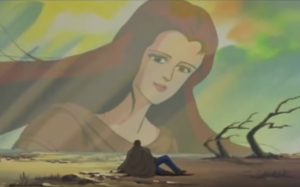 Saint Seiya‘s popularity can be explained relatively easily – it was a very well-made manga that appealed to a large demographic and rode an already very high wave. But that wave was started by Hokuto – while there have been violent martial arts manga before, it was Hokuto that solidified the genre. But why? How come so many people fell in love with it? Sure, it was good, but there have been plenty of great manga over the years, and very few have endured the way Hokuto has. What is its secret? After all, on paper the concept sounds absolutely terrible – a boring guy who’s the best at everything going around a bland desert and solving everyone’s problems? No way that can ever go anywhere! And yes, in a way you’d make some pretty valid points, but the true strength of Hokuto aren’t its world, characters or story. It’s how they are all presented within the narrative. Let’s take a closer look at the manga’s very first chapter and see what we can get from it!
Saint Seiya‘s popularity can be explained relatively easily – it was a very well-made manga that appealed to a large demographic and rode an already very high wave. But that wave was started by Hokuto – while there have been violent martial arts manga before, it was Hokuto that solidified the genre. But why? How come so many people fell in love with it? Sure, it was good, but there have been plenty of great manga over the years, and very few have endured the way Hokuto has. What is its secret? After all, on paper the concept sounds absolutely terrible – a boring guy who’s the best at everything going around a bland desert and solving everyone’s problems? No way that can ever go anywhere! And yes, in a way you’d make some pretty valid points, but the true strength of Hokuto aren’t its world, characters or story. It’s how they are all presented within the narrative. Let’s take a closer look at the manga’s very first chapter and see what we can get from it!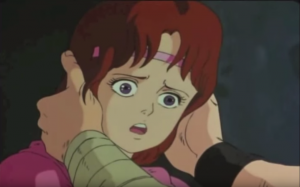 It’d be so easy to introduce Kenshiro in the middle of battle, kicking ass and taking names. Hell, that’s how a lot of manga introduce their protagonists in order to show just how badass they are. In fact, a lot of movies and videogames do the same, starting with a high-action scene to catch the viewer’s attention and establish the main character’s fighting prowess. But that’s not what Kenshiro is about. Sure, he can make your head explode with a punch, but he has never been defined by his fighting ability, and Hokuto wants you to know it. While we do see the results of one of his rampages, we never see him actually fighting anyone. Instead, we see him stumble into a village exhausted and dehydrated. This is another important lesson about our protagonist – he’s not an all-powerful god. While he does possess immeasurable martial arts skills, he’s still very much human and is subject to the very same weaknesses that the average human is. Mistaking him for a bandit, the villagers quickly lock him up alongside an actual bandit – Bat, a young boy who grew up in the midst of the apocalypse and had to learn to survive in it. When Bat attempts to assault their warden – an 8 year old mute girl by the name of Rin, who was trying to bring them some water – Kenshiro not only refuses to help him, but actually pushes a pressure point on his arm to make him let go of Rin. When asked why he would sacrifice his freedom like this, Kenshiro merely responds with “What do you think would’ve happened to the girl had we escaped?” Placing innocent lives before his own has always been one of the character traits that has truly defined Kenshiro. Soon afterwards, we see him use his knowledge of pressure points to cure Rin of her muteness. This is the very first time we’ve seen him use his devastating powers… and it is to help a child speak.
It’d be so easy to introduce Kenshiro in the middle of battle, kicking ass and taking names. Hell, that’s how a lot of manga introduce their protagonists in order to show just how badass they are. In fact, a lot of movies and videogames do the same, starting with a high-action scene to catch the viewer’s attention and establish the main character’s fighting prowess. But that’s not what Kenshiro is about. Sure, he can make your head explode with a punch, but he has never been defined by his fighting ability, and Hokuto wants you to know it. While we do see the results of one of his rampages, we never see him actually fighting anyone. Instead, we see him stumble into a village exhausted and dehydrated. This is another important lesson about our protagonist – he’s not an all-powerful god. While he does possess immeasurable martial arts skills, he’s still very much human and is subject to the very same weaknesses that the average human is. Mistaking him for a bandit, the villagers quickly lock him up alongside an actual bandit – Bat, a young boy who grew up in the midst of the apocalypse and had to learn to survive in it. When Bat attempts to assault their warden – an 8 year old mute girl by the name of Rin, who was trying to bring them some water – Kenshiro not only refuses to help him, but actually pushes a pressure point on his arm to make him let go of Rin. When asked why he would sacrifice his freedom like this, Kenshiro merely responds with “What do you think would’ve happened to the girl had we escaped?” Placing innocent lives before his own has always been one of the character traits that has truly defined Kenshiro. Soon afterwards, we see him use his knowledge of pressure points to cure Rin of her muteness. This is the very first time we’ve seen him use his devastating powers… and it is to help a child speak.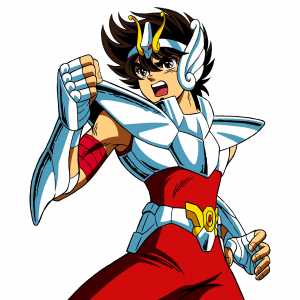 Let me take you back to early 80s Japan. The country’s economy is in a boom – the highest point since the war, with an average of 4% growth per year throughout the decade. Unemployment is at less than 5%. Japanese people suddenly found themselves with a lot of disposable income, which led to a natural increase in entertainment products, such as movies and comic books. Additionally, videogames such as Donkey Kong and Super Mario Bros. gain Japan worldwide recognition, forever sealing its place as the premier developer of videogames – a position that it would hold for at least the next 20 years, and arguably for a lot more. But there was another character created around the same time who, while not nearly as popular as Mario, proved to be just as influential. His name… is Kenshiro.
Let me take you back to early 80s Japan. The country’s economy is in a boom – the highest point since the war, with an average of 4% growth per year throughout the decade. Unemployment is at less than 5%. Japanese people suddenly found themselves with a lot of disposable income, which led to a natural increase in entertainment products, such as movies and comic books. Additionally, videogames such as Donkey Kong and Super Mario Bros. gain Japan worldwide recognition, forever sealing its place as the premier developer of videogames – a position that it would hold for at least the next 20 years, and arguably for a lot more. But there was another character created around the same time who, while not nearly as popular as Mario, proved to be just as influential. His name… is Kenshiro.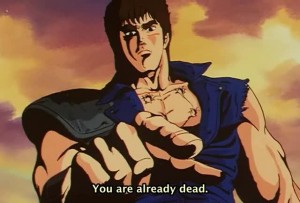 Hokuto‘s popularity gave rise to martial arts mangas that followed the same formula. Numerous attempts were made, some successful (such as 1984’s DragonBall) and some not. One of those attempts was Saint Seiya, created by Masami Kurumada. While not a direct ripoff of Hokuto, the influences were obvious – Saint Seiya also had a highly masculine protagonist (though more emotionally than physically) who used martial arts to right wrongs. But there were also several differences – for example, instead of a desolate wasteland, the Saints (Saint Seiya‘s word for martial artist) fought in a world that mixed sci-fi and Greek mythology settings, and instead of a sole protagonist wandering with a small supporting cast that mostly cheer him on, main character Seiya was joined by four other Saints. But there was another extremely important difference, one that I believe helped elevate Saint Seiya above the status as “just another martial arts” manga. While Hokuto no Ken was aimed at adults, with hyper-violence, complex themes and often depressing or bittersweet endings, and DragonBall was unquestionably aimed at little boys, with a child protagonist, simple plots and unquestionably evil bad guys, Saint Seiya managed to hit the tonal middle ground in order to appeal to almost everyone.
Hokuto‘s popularity gave rise to martial arts mangas that followed the same formula. Numerous attempts were made, some successful (such as 1984’s DragonBall) and some not. One of those attempts was Saint Seiya, created by Masami Kurumada. While not a direct ripoff of Hokuto, the influences were obvious – Saint Seiya also had a highly masculine protagonist (though more emotionally than physically) who used martial arts to right wrongs. But there were also several differences – for example, instead of a desolate wasteland, the Saints (Saint Seiya‘s word for martial artist) fought in a world that mixed sci-fi and Greek mythology settings, and instead of a sole protagonist wandering with a small supporting cast that mostly cheer him on, main character Seiya was joined by four other Saints. But there was another extremely important difference, one that I believe helped elevate Saint Seiya above the status as “just another martial arts” manga. While Hokuto no Ken was aimed at adults, with hyper-violence, complex themes and often depressing or bittersweet endings, and DragonBall was unquestionably aimed at little boys, with a child protagonist, simple plots and unquestionably evil bad guys, Saint Seiya managed to hit the tonal middle ground in order to appeal to almost everyone.